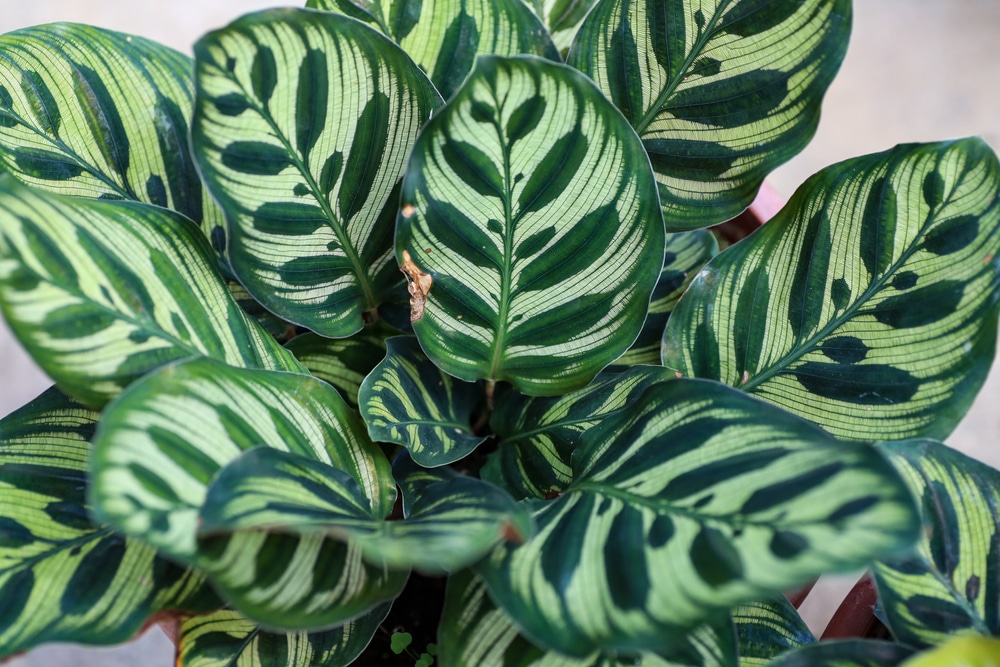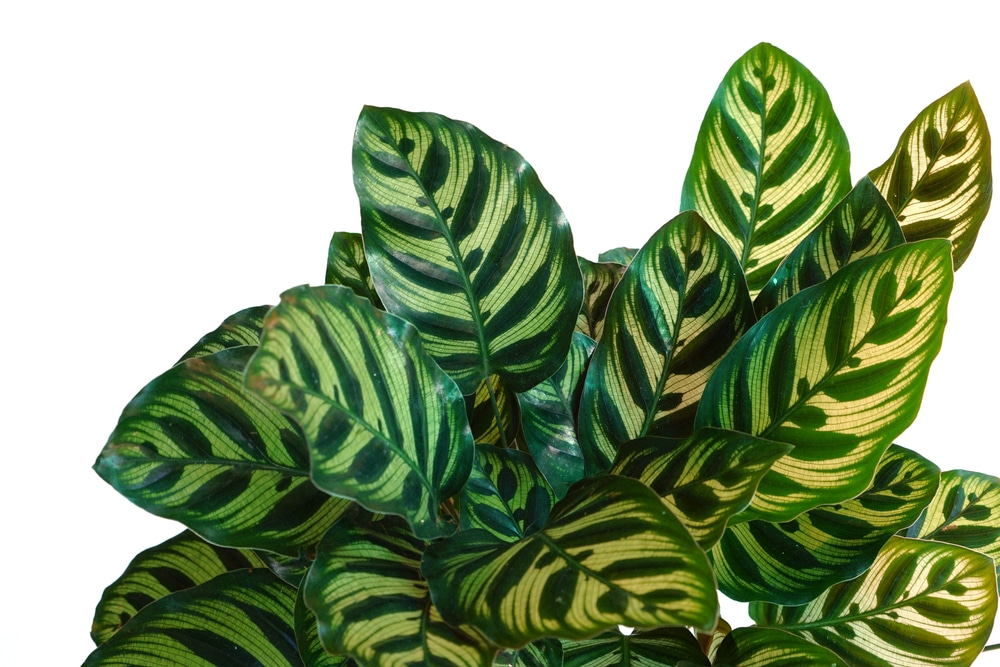The Calathea peacock plant (Calathea makoyana) is a beautiful, flowering houseplant that gets its name from its strikingly patterned leaves. These eye-catching plants are often found as part of indoor collections, as they make for beautiful decorative pieces. But besides their good looks, Calathea peacock plants are also easy to care for.
Seeing these plants flourish in your home is a satisfying experience, but it does require some knowledge and effort on your part. This guide will cover everything you need to know about Calathea peacock plant care.
| Botanical Name | Calathea Makoyana |
| Common Name | Calathea Peacock, Cathedral Windows |
| Plant Type | Perennial |
| Flower Color | Clusters of tiny white flowers |
| Size When Mature | 48 inches |
| Bloom Time | Anytime during the year |
| Sun Requirements | Partial sun, tolerates shade |
| USDA Hardiness Zones | 10 – 11 |
| Soil PH Range | 6.0 – 7.0 |
| Soil Type | Acidic to slightly alkaline, moist but well-draining soil |
| Water Needs | Medium |
| Native Area | Brazil |
What You Need to Know About Calathea Peacock
Known for its vibrant foliage, the leaves are oval-shaped with feathery, scalloped edges and a purple underside. Its leaves have spectacular patterns in different hues like cream, pink, green, gray, and white. The stems have a deep reddish-maroon shade, beautifully complementing the leaves.
The Calathea peacock is a tropical plant native to Brazil. It’s part of the Marantaceae family, which includes other popular houseplants like the Calathea roseopicta and Stromanthe sanguinea.
Peacock plants are a beautiful and exotic addition to any home, but they can be a bit finicky. They prefer warm, humid conditions and bright, indirect light, so they’re not the best choice for beginners.
If you can provide the right environment, though, you’ll be rewarded with a plant that’s sure to impress. The leaves of a peacock plant are large and glossy, with a distinctive marbled pattern. The flowers are equally stunning and bloom multiple times a year. Although its flowers are tiny, they surely add to the plant’s overall appeal.
How to Care for Calathea Peacock
Here’s everything you need to know about growing and caring for a thriving Calathea peacock plant:
Light
The Calathea peacock, with its bold, colorful leaves, does best in bright, indirect light. These plants aren’t tolerant of intense, direct sunlight, which can cause the foliage’s colors and patterns to fade.
Filtered light is what these plant like most, but they can also tolerate full shade. However, take note that growing in full shade means that your plant’s growth is significantly slower.
In their natural habitat, Calathea peacocks often grow beneath the canopy of taller trees, receiving dappled sunlight throughout the day. This type of light is ideal for these plants, as it helps to maintain their vibrant colors and prevent leaf scorching.
Water and Soil Needs
Choose a potting medium that can retain moisture but fairly drains well. This is one of the main requirements for your Calathea peacock to thrive. The ideal soil mix for a peacock plant would be sand, peat, and perlite. However, you can always use a general potting mix and amend it with some extra peat or perlite to improve drainage.
As for the soil pH range, a slightly acidic to neutral pH level from 6.0 – 7.0 would be best.
When it comes to watering, getting the right balance is often the most difficult part. Too little and its leaves will turn brittle, but too much can cause the plant to rot. The best way to tell if your peacock plant needs watering is to check the soil.
Allow the top layer of the potting mix to dry out completely before watering again. When you do water, make sure to soak the entire pot until water starts draining from the bottom. Allow the plant to drain fully before putting it back in its spot.
It helps if you have a moisture meter on hand to help you keep track of the moisture levels in the potting mix. This will take out the guesswork and help you avoid overwatering or underwatering your plant.
Temperature Requirements
Considering these plants are from the tropical regions of Brazil, they like environmental temperatures between 60 – 70 degrees Fahrenheit. They don’t do well in cold or drafty areas, and temperatures below 60 degrees Fahrenheit can cause the leaves to develop brown spots.
Fertilizer
The best fertilizer to use on a Calathea peacock plant is a water-soluble fertilizer with a 3-1-2 NPK ratio. Use this fertilizer once a month, diluting it to half-strength to avoid burning the roots. Alternatively, using a balanced, all-purpose fertilizer once a month at full strength will also work well.
Common Diseases
Pseudomonas leaf spot and root rot are two of the most common diseases that affect Calathea peacock plants.
Pseudomonas leaf spot is characterized by brown or black spots on the leaves. The spots are often surrounded by a yellow halo, and if left untreated, the disease can spread quickly and cause the leaves to drop off.
To prevent this disease from occurring, make sure to water the plant at the base and avoid getting the leaves wet. If the plant is already infected, you can treat it with a fungicide or bactericide.
Root rot is another common disease that affects Calathea peacock plants. This fungal disease occurs when the roots are left sitting in water for too long, causing them to rot. Symptoms include yellowing and wilting leaves, as well as stunted growth.
Calathea Peacock Propagation
Propagating through stem cuttings is still one of the fastest and easiest ways to get more plants.
Choose a mature and healthy stem, and cut it right below the leaf nodes. You have two options: you can let the cuttings root in water or in soil.
While both are relatively easy to do, soil is often the preferred method since its roots are often stronger than those that have been rooted in water.
Wait for about a week or two for the roots to develop. You’ll know when they’re ready to transplant to their individual pots when the roots are about an inch to an inch and a half long.
Related Article: Calathea White Fusion


